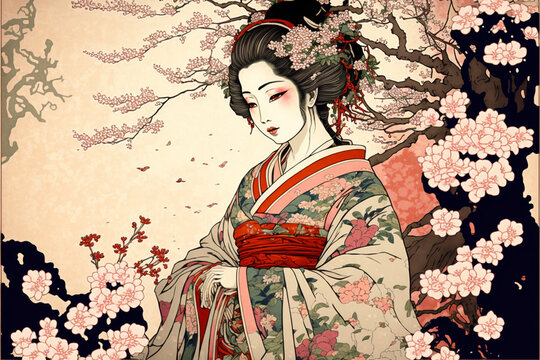Table of Contents
Japan is a country that is rich in history, culture, and art. Japanese art has always been known for its beauty, delicacy, and uniqueness. It is fascinating to see how the country’s ancient roots influence their current art forms. From traditional architecture to exquisite craftsmanship, Japan’s art scene has something to offer everyone. In this blog post, we will explore the wonders of Japanese art in detail. We will delve into the ancient roots of Japanese art and how it has evolved over the years. We will also discuss traditional Japanese architecture, the elegance of craftsmanship in various art forms such as ceramics and textiles, and contemporary art in Japan. Get ready to be mesmerized by the beauty of Japanese Art!
Ancient Roots of Japanese Art
Japanese art has a rich history dating back to the 6th century BCE. Buddhism and Shinto have played significant roles in shaping Japanese art, incorporating spiritual and cultural elements. Early Japanese art forms show influences from China and Korea, reflecting the interconnectedness of Asian cultures. During the Edo period, woodblock prints gained popularity as a distinct art form. Nature and the natural world have always been a major source of inspiration for Japanese artists. From the rest of the world, Japan has created its own style, with unique contributions in ceramics, ink painting, lacquerware, metalwork, and more. These ancient roots continue to influence contemporary Japanese art.
Traditional Japanese Architecture
Traditional Japanese architecture draws inspiration from nature, embodying simplicity and minimalism. Key features of this architectural style include tatami flooring, sliding doors, and paper screens. Natural materials like wood, bamboo, and stone are integral to its design. The seamless integration between indoor and outdoor spaces is a defining characteristic. Examples of renowned traditional Japanese architecture include the Kiyomizu-dera temple in Kyoto and the Himeji Castle. With a strong emphasis on harmony with nature, traditional Japanese architecture creates a tranquil and serene ambiance. It showcases the unique cultural identity and artistic sensibility of Japan, making it an important aspect of the country’s rich artistic heritage.
Craftsmanship in Japanese Art
Craftsmanship in Japanese art is characterized by its attention to detail and precision. From calligraphy to pottery, intricate details are meticulously crafted. Natural materials like wood, bamboo, and silk are often used, reflecting a deep connection to nature. Japanese art expresses emotion and captures the essence of beauty, with dynamic brushstrokes and serene gardens evoking different feelings. While rooted in tradition, Japanese art also embraces innovation, as contemporary artists bring new ideas and techniques to the forefront. Cultural influences, such as Zen Buddhism and the tea ceremony, play an important role in shaping the distinct style of Japanese art.
Contemporary Art in Japan
After World War II, contemporary art in Japan experienced significant growth. Contemporary artists in Japan were heavily influenced by traditional Japanese art and culture, incorporating elements such as ink painting and ceramics into their works. The emergence of new media, including digital and performance art, brought fresh perspectives to the contemporary art scene. Galleries and museums played an important role in promoting and showcasing Japanese contemporary art to the rest of the world. The impact of globalization on Japanese art allowed it to gain recognition and establish its place in the international art community.
What are some of the key features and characteristics of Japanese art?
Japanese art is renowned for its simplicity, elegance, and meticulous attention to detail. It often showcases nature themes like cherry blossoms, mountains, and water. Traditional Japanese art encompasses calligraphy, ukiyo-e woodblock prints, pottery, Shibori dyeing, and Origami paper folding.
How has Japanese art influenced other cultures and artistic movements?
Japanese art has left a profound impact on various cultures and artistic movements. From inspiring Impressionism and Art Nouveau to influencing minimalist art through the concept of negative space, Japanese art’s influence is far-reaching. The revered ukiyo-e woodblock prints and the Zen philosophy behind many Japanese art forms have also had a significant influence on artists worldwide.
How can I learn more about the history and techniques used in traditional Japanese art?
To dive deeper into the history and techniques of traditional Japanese art, you can explore museums, read books and articles, attend workshops or classes, and watch documentaries or videos. These resources provide valuable insights into the rich culture and artistic practices of Japan.
What are some notable examples of famous Japanese artists and their works?
Some notable examples of famous Japanese artists and their works include Hokusai, known for “The Great Wave off Kanagawa,” and Yayoi Kusama, famous for her colorful polka dot artworks. Katsushika Hokusai’s iconic series “Thirty-six Views of Mount Fuji” and Hiroshige’s “One Hundred Famous Views of Edo” are also noteworthy.
How has modern Japanese art evolved from its traditional roots?
Modern Japanese art has undergone a transformation from its traditional roots. Influenced by Western styles and techniques, artists have combined traditional art forms with modern concepts and materials. Reflecting current social and political issues, contemporary Japanese art has gained international recognition and is exhibited worldwide.
What are some notable examples of Japanese art that have gained international recognition?
Japanese art is a testament to the rich cultural heritage and creativity of the country. From the ancient roots of Japanese art to the exquisite craftsmanship and traditional architecture, Japan has an artistic tradition that continues to evolve in the contemporary era. The delicate brush strokes of ink paintings, the intricate details of woodblock prints, and the harmonious blend of nature and spirituality in traditional Japanese art are all awe-inspiring. The influence of Japanese art can also be seen in modern art forms, such as manga and anime. Exploring the wonders of Japanese art allows us to appreciate the depth of creativity and innovation that has shaped this vibrant artistic tradition.

